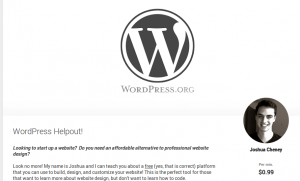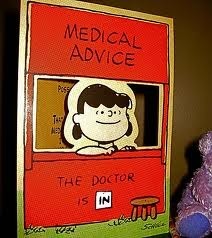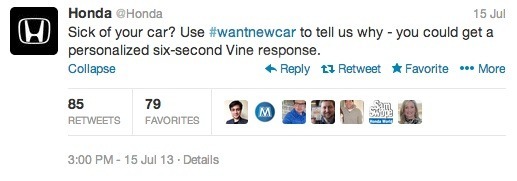Erik Qualman's Blog, page 623
November 7, 2013
Google Helpouts: The Perfect Adaptation to Smart Marketing

Today, Google released a new virtual video web service, Helpouts, which provides real-time help for just about anything. Google has taken its success from search, email, maps, and other tools, and turned it into a more interactive and useful platform, expanding its service base and increasing market share.
Whether its seeking help for a craft project or learning a new yoga pose, there is a Google Helpout expert waiting on standby to help you. This video gives a brief overview of the new service.
The beauty of this new service is two-fold. For small business owners looking to market their services, this provides another avenue to do so by providing expertise and achieving a high rating from a Helpout experience.
For example, if I am looking to create a WordPress blog, but don’t know quite how to do so, I can simply do a search and the category of Computers & Electronics unfolds a menu of “Helpers” listed in order of “Best Match.” You can also change the order based on “Soonest available, Lowest Price, and Best Reputation,” depending on your need.

WordPress- Google Helpout
A beneficial feature to point out is the person-to-person bio and background features. For the WordPress example, I feel like I “know” Joshua because of his headshot, and the “Meet Joshua” section allows me to explore and research Joshua’s creditials before hiring him for a Helpout.
The ability to research a person, company, or service prior to usage is Google’s way of utilizing Jay Baer’s concept of Youtility. In his book, Youtility: Why Smart Marketing is About Help Not Hype, Baer discusses why self-serve information such as Joshua’s ratings and reviews provide greater insight for the user and credibility for Joshua. This also gives individuals that are experts at teaching a skill or technique the opportunity to share their knowledge and information.

Meet Joshua
According to Landon Robinson of Best Techie, Google Helpouts will work with large companies such as Weight Watchers and Rosetta Stone to provide assistance with specific products and/or services. Another feature of the service is the ability to share screens with the Helper, edit documents, and record the Hangout (Google’s video-conferencing platform) for playback at a later time.
It can be anticipated that the service will build momentum over time as users become more comfortable with the platform and usability. It will be exciting to see the progress and improvements as users begin to adapt to the new web service.
For additional information, please visit the Google Helpouts page.
[image error]
November 1, 2013
Changes to Organic Keyword Search Data Impacts Social Web Marketers


Google is no longer offering analytic information on organic keyword searches to website owners. When site owners check their analytic data to see how traffic is coming to their own sites, they will only see Google’s keyword information as “(not provided).” Google’s move to keyword encryption not only affects webmasters, but also consumer and B2B marketing teams, social media strategists, bloggers and others. It is having a widespread impact on the entire Web marketing, SEO and social media landscape.
Keyword Encryption
To longtime SEO professionals, this change was not a big surprise. The process of limiting data from organic keyword searches started in October 2011. But the search giant’s efforts kicked in more feverishly in the past few months. A recent study from data analysts Parse.ly showed that about 87 percent of traffic going to large news sites was being encrypted and showing up in reports as (not provided). Google started blocking more data in 2012 and into this year. By October, it was shut down completely, writes Business Insider.
Google said its moves were to protect user privacy, but many others see it as a commerce-minded attempt to drive more websites, marketers and SEO pros to pay up for Google AdWords (where this information is open to subscribers). The free organic data that was the bread and butter for SEO pros over the last few years is done. Google is only providing keyword traffic data for web advertisers who pay Google for some of the Google products services.
Impact on Marketers
The effect on marketers has been strong. They are scrambling to find other ways to get the data they need. Bloggers are unsure who’s reading their posts. Dean Praetorius, director of trends and social media for Web publisher Huffington Post, told Ad Age that his team would have to look at search patterns gained over the last seven years of content and look for similarities in traffic and language patterns.
Your marketing and social team can look to see how others in the business are coping with the latest round of Google changes. For starters, look to Search Engine Land, Search Engine Journal and the iAcquire marketing and SEO blog for strategies and workarounds for the (not provided) keyword encryption.
How else is this impacting marketers?
Difficulty in assessing insights about customers issues: When prospects come to a site, marketers were able to see which search terms led them there. Now, they are shooting in the dark. Google Webmaster Tools may help a bit, but not to the earlier levels of insight.
Difficulty in optimizing SEO: How are marketers and social media managers supposed to optimize their site when they can’t see the inbound traffic? While there are other metrics to check on certain Web visits, it’s expected that these changes will lead more marketers to produce and deliver great content on their sites for visitors.
Future Scenarios
Neil Patel of QuickSprout suggests that creating awesome content instead of focusing on optimizing keywords will eventually help most marketers get better overall. Marketers should focus more on thought-provoking infographics; consistently write good blog post material that energizes the readership gained at the blog; and experiment with work-centric webinars, podcasts and videos to test the range of interest in their subjects. Most of all, link and leverage your social media efforts to everything you do.
If (not provided) teaches us anything, it’s that companies online are refining their Internet strategies to what works best for everyone. Keyword-heavy blog posts that were of no use to readers are out; excellent, relevant content that helps readers and Web searchers are in.
Moving forward, there will be a greater emphasis on content with articles, blogs, videos, podcasts, presentations and more, over strict keyword search information. That may be a good thing for Internet business. Quality content will tie into social media sharing opportunities. This is especially important for those banking on Google+ for new insights. As Google ties everything together for individual users on the Web via Google+, this will impact individual bloggers on search listings and blog post traffic, as well.
[image error]
October 31, 2013
Why Google+ is an Essential Part of Your Social Strategy
[image error]
While its 2011 launch debut was easily forgotten, Google+ usage has quietly but steadily been growing. So much so, in fact, that usage of the site now surpasses both LinkedIn and Twitter, with over 343 million users and 34% of all social logins, according to a recent study commissioned by Janrain. Google+ now seems more poised than any other social media platform to dethrone Facebook in terms of social sharing.
For businesses that haven’t integrated Google+ into their social strategy yet, let’s take a deeper look at just why you should be taking G+ seriously and how you can make the most of all it has to offer.
Why Businesses Should Use Google+
1) Social Logins Matter
Businesses and marketers need to gather crucial information on potential users signing up for their site, but the more hoops people have to jump through, whether that’s the number of clicks or the number of information boxes that need to be filled out, the less likely they’ll continue through the process until they’re all signed up.
Social login eliminates that problem by allowing users to sign up for and into accounts with their favorite social media sites. For businesses, that means that the more people who sign up for G+, the more pressing it is to provide G+ as an easy sign up option. Doing so will also help provide instant permission-based access to the user’s social profile data, which includes demographic, psychographic and social graph data, all of which is really invaluable to targeting relevant marketing efforts.
2) Google Search Loves Social Sharing
Google’s search algorithms matter (Obvious, right?). And those algorithms really care about social sharing, as each share tells them that any given piece of content is valuable and trustworthy. That’s true regardless of the social media site you’re on, but it’s all the more powerful with G+, as it ties in directly with Google’s search products. A G+ business page, particularly a Google+ Local page, will go a long way in ranking you higher in search results. Doing so will get your page instantly displayed on the side bar for local searches, along with a host of reviews and user rankings that will immediately build trust with searchers.
3) Customers Trust Google+ Business Results
According to the Janrain study, the G+ social login is particularly trusted when used to access brands and retailers. This may be another favorable indication of just how much customers trust Google as the provider of accurate information and products. When businesses use G+, they get to piggyback on that trusting relationship.
4) Google+ is a Part of the Google Suite
The great thing about G+ is that it comes with all of Google’s other awesome products. Want to lay a few things out for customers in a Google Hangout? Just install the Google Drive app and you can present right from your video chat. Want to instantly provide any web searcher with all of your information and all of your social content? Google+ lets you do that too. It’s an all-in-one marketing platform.
5) G+ is Visually Engaging
More visuals, less talk. That’s what it seems many of today’s web browsers prefer, and that’s what G+ embraces. With a stunning cover photo and a diverse, Pinterest-like feed, your content will be instantly compelling in G+’s visually pleasing format.
Best Practices of Google+
So how can you use G+ and its many powerful new tools to your full advantage?
1. Diversify Your Content
Posting on G+ (and really, on any social media channel) means going beyond the traditional advertising approach. No one wants to hear you shouting about your products while they’re just trying to chat with some friends about the latest grumpy cat meme. As a rule of thumb, it’s best to think of 80% of your content as media content and 20% as promotional. This means keeping your media approach relevant, helpful, fun and varied.
Get to know your audience. There’s no use making a joke about spaceships if your audience isn’t interested in spaceships. As more people join you, take the time to read their profiles and feeds to get a sense of just who they are and what kind of content they like reading. Then categorize them into circles so that you can share only the most relevant content with them and so that you can drop in on them from time to time to keep your relationship warm.
Become a member of the media. There are two strategies for getting great content: make it yourself or curate it. To do the latter, follow great content creators and influencers so you can repost what they’re posting. For your own content, keep in mind that you don’t necessarily have to write a long expertise blogpost every time. Instead, try how to videos, a vine-like short that gives your customers a glimpse into your offices or brand, photos or infographics. Try hopping onto one of G+’s trending topics so that you know you’ve got an instant audience for whatever you’re posting.
Get on a schedule. The quickest way to get off track (and start procrastinating) is not having a plan. Take the time to plan out your G+ posts a month ahead of time so you’ll always know what you’re supposed to be doing. This doesn’t necessarily mean knowing exactly what you’ll write, but it does mean knowing that on this coming Monday, it’s time to post a photo. No excuses!
2. Post With Engagement in Mind
Posting a great photo on G+ won’t have much use to you if nobody shares it, checks out your website or moseys any further down your sales funnel. User engagement is absolutely key if it’s going to be worth your time.
Make sharing easy. Link your G+ page to your website with a G+ badge so your followers can easily see and re-share your content, whether they’re at your G+ page or on your website. For that matter, make sure that when you post to your blog, each post has a plus 1 button at the bottom.
Use hashtags. Just like on Twitter, hashtags on G+ highlight search terms, so if you have keywords you’d like your users to use to find your content, just put a hashtag in front of them. When users click on a hashtag in your post, they’ll find other related articles. Later on, they’ll also be able to re-find that great article you wrote, just by timing in that search term. That makes them much more likely to share, both at the time and further down the road.
Draw from user content. Hey, no one said you had to make all of your content yourself. Why not ask for user submissions to fill out your feed? Let’s say you market for a cupcake company. Why not invite followers to bake their own creative cupcakes and submit their photos for posting and voting? Followers will be a lot more likely to re-post and engage when their cupcakes are on the line!
3. Make Sure Your Google+ Strategy is Synced to Your Overall Brand Strategy
You don’t want your Facebook feed promoting one thing and your Google+ promoting something completely different, campaign-wise. You’ll totally confuse avid fans who follow more than one feed. Each social media channel should host different messages of the same campaign, but not the same exact message, either. Which is to say, content on your Google+ shouldn’t just be a carbon copy of the content you post on your other channels, or else you’re just spamming your followers with duplicate content and giving them no reason to follow all of your social media platforms.
Instead, show your followers that you have an expert grasp of the tools and audience available on each channel by crafting your posts to suit each platform. That cupcake company, for example, might tweet out hilarious 140 character cupcake haikus on Twitter while saving a live baking session for a Google+ Hangout on Air, which later can be archived and re-shared on YouTube. When you stick to the kind of content that’s intended for that particular social media platform, you’re much more likely to get shares.
Further Resources for Understanding Google+
To get started on Google+, start with Google’s own setup guide as well as this extensive Small Business Guide to Google+. With these resources, you’ll be a Google+ expert in no time, and the businesses you market for will reap the benefits. See you on Google+!
Feature Image courtesy of Shutterstock.com
Graph Image courtesy of Janrain.com
[image error]
October 30, 2013
Tips for Brands Using Social Media

By now, any marketer worth their weight in salt knows the importance of social media in your campaign efforts. Between it’s affordability, potential reach and audience engagement rates, there is no reason a strong social media strategy shouldn’t be fully integrated into your marketing setup. The really savvy marketers will also pick up on the topical aspect that Facebook, Twitter & their contemporaries all offer, whether that’s engaging with customers via trending hashtags or direct comments, or creating some specific holiday-themed content. So let’s run through some of the best practices and examples your brand can adopt for the upcoming festivities….
1.) Be Audience-centric:
The first, crucial thing to understand about social media is that it is controlled by users, for users. If your social media efforts are to be a success, your audience must make it so. Share and tweet things that are relevant to your demographic. Keep it informal and encourage viewers to join in, and if they do, engage with them. You’d be amazed at how small acts like that can reinforce a positive association with your brand. Don’t be afraid to join in trends on Twitter, too. Honda are great at this. A while back, the car manufacturers launched a campaign that sent personalized Vines to Honda fans on Twitter who use the hashtag #wantnewcar.
2.) Be Interesting
Studies into audience preferences have shown that, when clicking onto a brand’s fan page, they like to see something fresh, unusual or interesting – not the same old information they can find on your corporate website rehashed into 140 characters. Don’t think of your social media audience as a client you need to hard-sell to. Instead, think of them as needing to be wooed. The most successful Facebook pages and Twitter accounts use a variety of innovative apps and slick, stylish content to keep their audience engaged.
3.) Be a Friend
This may sound corny, but it works. Consumers want brands to communicate in simple, informal, conversational language – not over-technical jargon. Be open and honest. Transparency is a key for brands in social media and is the most critical factor in building trust. Don’t fool your community members into thinking you have a goody for them, only to trick them into a spam trap, either. Responding to unhappy customers will help rectify any mistakes made on your part.
Madeleine Hammond is a Marketing Executive at Skeleton Productions – One of the UK’s leading Video Production Comapnies.
[image error]
October 28, 2013
The Digital Secret To Getting A Second Chance For A First Impression

Isn’t it true that you never get a second chance for a first impression? Well…not anymore! That’s right my friend, this classic saying is now as worthless as the paperweight it is printed on.

In college, I worked as an intern for one of the largest recruiting firms in the country. Candidate’s chances of getting an interview relied on the words printed on a single sheet of paper or if they were lucky an employee or previous hire referral. The web and social media was never considered because it was 2006 for goodness sake. That’s hundreds of years ago in Internet time. 99% of the candidate’s first impression was riding on the live face-to-face interview.

Today, recruiters are leveraging LinkedIn, Facebook, Twitter, Tumblr, YouTube, Identified.com and Klout to make a pre-impression before they ever consider the candidate for a first impression.
“Never get a second chance for a first impression” should now be replaced by “Never get a first impression without a solid pre-impression.” Some of you may be thinking, “Well, if the pre-impression happens first than it is now the first impression” – good thought but work with me

The aspects that made a solid first impression – appearance, manners and the firm, credibility-boosting handshake – are now happening online. Constant clammy hand people rejoice! Pre-impressions are what recruiters, online daters and digital natives are instantly forming to qualify if a first impression is worth the time and energy.
Most of my business introductions now happen via LinkedIn which makes it easy for me to instantly view their profile, website and all social media platforms to gain context around the individual and form an impression. If you are nonexistent online, that communicates the wrong thing. If nothing comes up on a quick Google search, I question if you are still alive or if you’ve left the darkness of your basement in the last few years. And if you only have 132 LinkedIn connections, I’m going to assume you are a farmer because that is simply unacceptable for anyone in business today.
While attending conferences, classes or church we still experience true first impressions when we meet people face-to-face for the first time. Face-to-face communication skills are still uber crucial today. But if you happen to botch a crucial first impression with a front-and-center coffee stain on your shirt, today’s social web provides you with the once non-existent second chance needed to redeem yourself.
Social media provides the means to easily connect again for that second chance. And your online presence (aka personal brand) gives you the second chance to show the other person what value you bring, who you really are and what you are truly capable of.
Creating solid context online (via blogs, social media, websites, etc.) will help strengthen your rapport offline. Supplement your genuine smile, kick-ass personality and epic leadership with a strong online presence and kiss unimpressive first impressions good-bye.
Question: How do you form your impression of people in today’s digital age?
[image error]
October 27, 2013
How is the Government Using Social Networking to Promote the Affordable Care Act?

The days of the President offering a weekly radio address only are long over.
The government is now turning to the most up-to-date social media channels to promote Obamacare.
Turning to Social Media
Complications with the Obamacare website have led to a lot of criticism. A lot of critics are expressing their displeasure via social media.
Since there are likely more people using Facebook than reading the latest government reports, the government is now using social media to combat the negative press. The government is attempting to reach both supporters and critics to provide updates and information on Obamacare.
Reaching the Target Audience
Social media allows the government to reach their target audience. The government has started social media sites in Spanish so that they can reach the Latino population easily.
Social media also allows the backers of Obamacare to reach out to specific age groups. Many ads and posts are targeted toward the younger population to ensure that they are aware of the marketplace.
Timing Ads According to Special Events
The Obama administration has also created specific social media posts and marketing strategies with specific events and dates in mind.
For example, marketing efforts around Mother’s Day included posts about the importance of children having health insurance.
Reaching Facebook Fans
The healthcare.gov Facebook page has attracted more than 200,000 likes. Updates have been offered to fans which promote the reasons for affordable health insurance.
There are a variety of pictures and infographics that explain the sign-up process. Other posts acknowledge the difficulties users are finding in signing up on the website.
The Facebook page offers a variety of videos that explain the sign-up process and show fans how the marketplace works. There is also a help center that links people directly to a live chat option so they can ask specific questions or talk to someone about their experience.
Tweeting About Obamacare
The Obamacare administration has developed its own Twitter account.
Although the account has less than 7,000 followers, the government is tweeting to spread the word about Obamacare.
The Twitter account sends out educational and information tweets about how many people prove to be signing up and any changes that are taking place on the government website. They’re also re-tweeting posts from people who are sending positive messages about their experiences signing up for health insurance.
Promoting Badges and Widgets
Obamacare is also using various badges and widgets on all of its healthcare websites. Advertisements encourage users to visit the marketplace to sign up for insurance.
Bloggers and website owners are also encouraged to download these badges to help direct traffic to the marketplace. These advertisements can ensure that people who are reading about healthcare or other topics may learn more about the sign-up process.
Hiring People to Spread the Word
The Obamacare administration has hired celebrities to spread the word about the healthcare marketplace.
For example, the Baltimore Ravens were recently granted $130,000 to promote Maryland’s healthcare marketplace.
The Raven’s will feature a badge on their website directing traffic to the website. They will also send out five tweets about Obamacare in an effort to reach the younger male population.
The government’s participation in social media is certainly a sign of the times.
It shows the importance of using various social media platforms for online reputation management, even when it means discussing hot potato political issues.
Photo credit: foxnews.com
[image error]
How is the Government Using Social Networking to Promote Obamacare?

The days of the President offering a weekly radio address only are long over.
The government is now turning to the most up-to-date social media channels to promote Obamacare.
Turning to Social Media
Complications with the Obamacare website have led to a lot of criticism. A lot of critics are expressing their displeasure via social media.
Since there are likely more people using Facebook than reading the latest government reports, the government is now using social media to combat the negative press. The government is attempting to reach both supporters and critics to provide updates and information on Obamacare.
Reaching the Target Audience
Social media allows the government to reach their target audience. The government has started social media sites in Spanish so that they can reach the Latino population easily.
Social media also allows the backers of Obamacare to reach out to specific age groups. Many ads and posts are targeted toward the younger population to ensure that they are aware of the marketplace.
Timing Ads According to Special Events
The Obama administration has also created specific social media posts and marketing strategies with specific events and dates in mind.
For example, marketing efforts around Mother’s Day included posts about the importance of children having health insurance.
Reaching Facebook Fans
The healthcare.gov Facebook page has attracted more than 200,000 likes. Updates have been offered to fans which promote the reasons for affordable health insurance.
There are a variety of pictures and infographics that explain the sign-up process. Other posts acknowledge the difficulties users are finding in signing up on the website.
The Facebook page offers a variety of videos that explain the sign-up process and show fans how the marketplace works. There is also a help center that links people directly to a live chat option so they can ask specific questions or talk to someone about their experience.
Tweeting About Obamacare
The Obamacare administration has developed its own Twitter account.
Although the account has less than 7,000 followers, the government is tweeting to spread the word about Obamacare.
The Twitter account sends out educational and information tweets about how many people prove to be signing up and any changes that are taking place on the government website. They’re also re-tweeting posts from people who are sending positive messages about their experiences signing up for health insurance.
Promoting Badges and Widgets
Obamacare is also using various badges and widgets on all of its healthcare websites. Advertisements encourage users to visit the marketplace to sign up for insurance.
Bloggers and website owners are also encouraged to download these badges to help direct traffic to the marketplace. These advertisements can ensure that people who are reading about healthcare or other topics may learn more about the sign-up process.
Hiring People to Spread the Word
The Obamacare administration has hired celebrities to spread the word about the healthcare marketplace.
For example, the Baltimore Ravens were recently granted $130,000 to promote Maryland’s healthcare marketplace.
The Raven’s will feature a badge on their website directing traffic to the website. They will also send out five tweets about Obamacare in an effort to reach the younger male population.
The government’s participation in social media is certainly a sign of the times.
It shows the importance of using various social media platforms for online reputation management, even when it means discussing hot potato political issues.
Photo credit: foxnews.com
[image error]
October 24, 2013
Facebook Newsfeed Visibility: 5 Quick Yet Powerful Ways to Increase It

1. Only Post Once a Day, Max
There is one thing we have learn at Dynamic Search, people do not want to hear too much from you. You wouldn’t stand outside of their house screaming about your product, so don’t do it on their newsfeed. Never post more than once per day — unless you have timely content that your online community has requested. People usually don’t unlike pages for lacking content, but they do if they perceive you be posting too much. Many think that if they post multiple times a day, they will capture a wider audience because most people are not logged in at any given time. While this is in fact true, there is another side to this coin. People scroll down, and if they see several posts from the same company, they get annoyed. Play it cool, hot shot.
2. Talk About What They Want to Engage With
Keep an eye on what people seem to like about you, and then play off of that. Don’t try to hit them over the head with information or trying to teach them something, unless they ask. Make the entry point to conversation fun and light, and when you build your network you can start posting more and more serious content promoting your brand.
A good posting technique is to give, give, and give again. The idea is to become the authority and trusted resource in your niche. Every once in a while you can release a post with some sort of call to action.
3. Post Images and Videos and Ask People to Caption
People are visually driven. Text updates don’t get nearly the exposure that a good meme or quality video can. Use this to your advantage. Share popular photos from your Pinterest or Instagram profile, or post a YouTube video that got lots of views. Requesting that people caption a photo or video can be a very effective way of engaging with your network. It makes them feel that what they wrote is important to you.
Caption this…
4. Request Feedback and Ask Questions
Asking people what they think about you and asking them questions are great ways to get them more involved. For instance, if you sell TV’s, maybe ask them: “What are you watching tonight?” Even a simple request for an opinion, and asking them what they think can boost your Facebook visibility and interaction because asking questions often gets more comments.
5.Target your Audience
Do you have Facebook fans from all over the world, or are you generally a more local (state, country, etc.) Is your page geared more towards younger or older users? Are they married? Have kids? Each factor plays a part.
Facebook now lets users post by relevance to gender, relationship status, educational status, “interested in,” age and language. So if you have posts that are meant for only a specific segment of your audience, target them. This will ensure that the people that want to see your messages will, making your brand more and more appealing on Facebook!
[image error]
October 23, 2013
The 2013 World Series Social Media Scorecard [infographic]

The World Series kicks off tonight in Boston and I could not be more excited! The Sox and Cards will face off in what, on paper, looks like a pretty good match-up. I have already made plans for each game but am still hoping to swing tickets for tonight’s game!
Being a fan of both the Red Sox and Social Media, I was especially excited to find this gem of an infographic in my inbox this morning. It was put together by the team at Sysomos and outlines the social power of both teams. The only area I have some issues with is the ‘Fan Cave’ section of the infographic. The reason is it only accounts for the number of tweets sent by an individual about the Red Sox or Cardinals. I’d much prefer to see a section that highlights the most influential Red Sox fans by not only looking at tweets sent but calculating engagement on the tweets (retweets, favorites, replies), number of followers, and sentiment. Kind of like a Klout score for baseball fans.
That said, it’s still a great infograhic! Especially because, from a social perspective, the Sox have the Cards beat!
Hope you enjoy and #GOSOX!
[image error]
October 22, 2013
Get Healthier By Using Social Media

 Although some doctors express concern about people spending too much time engaging in sedentary activity, such as using social media, there are ways in which social media can be used as a tool to improve your health.
Although some doctors express concern about people spending too much time engaging in sedentary activity, such as using social media, there are ways in which social media can be used as a tool to improve your health.
With a little creativity, social media can provide you with education, support, and accountability as you try to live a healthier lifestyle.
Read Reviews
One important way in which social media can help you get healthier is by giving you personalized information about doctors, hospitals, and medical centers.
There are many social media platforms that allow you to read what others have to say about their medical experiences.
For example, you can read doctor reviews on many social media websites.
People can grade their doctor on a variety of factors and offer information about their experiences at the doctor’s office. Reading reviews can help ensure you find the doctor that is most likely going to be a good match for your medical needs.
Connect with Others
Social media offers an excellent opportunity to connect with other people who share similar medical conditions or problems.
For example, you can join a support group on Facebook or follow an expert on Twitter to learn more about specific health conditions.
This can be especially helpful for people who have obscure medical conditions. They no longer have to feel isolated when it comes to dealing with their symptoms. Instead, they can talk to others about their experiences and gain support.
Family members can also benefit from this.
There are groups for parents raising a child with a particular illness or people looking for support for a spouse’s medical condition.
Get Educated About Your Health
Social media provides many opportunities for the public to become educated about various health issues. You can read about various health conditions, treatment options, medications, and complications on a variety of reputable websites.
When people educate themselves about their health, it helps them prevent many medical problems too. People can become more aware of how to prevent certain conditions or treat minor problems before they become serious.
Use Apps to Monitor Your Health
There are a variety of apps that can allow people to monitor their health and fitness as well. You can find anything ranging from calorie counters to blood sugar diaries that can help you manage your health.
Many apps include a social media aspect.
For example, some fitness apps allow people to share their goals with others and then the app can help people share their information with friends and family.
Sharing information about your fitness goals can increase accountability.
You can log how much you’ve exercised, tell others whether or not you’re on track, and help cheer others on as they try to reach their goals.
Start Looking for Social Media Sources
There are a variety of social media platforms that offer ways to manage your health.
For example, Facebook and Twitter allow you to follow your favorite fitness magazines or medical professionals easily. You can get daily tips and advice about how to stay healthy.
Pinterest offers a variety of inspirational images and quotes that can be helpful. Looking at regular reminders can assist you in reaching your goals and staying motivated to focus on your health.
Blogs and forums can also provide you with a lot of useful information about your health. You can find plenty of them that focus on general health issues or specific conditions.
Social media is a great way to connect with other people around the world about various health issues.
It offers a variety of professional information as well as personal experiences which can be very helpful when you’re researching your own health issues.
Photo credit: bilerico.com
[image error]












